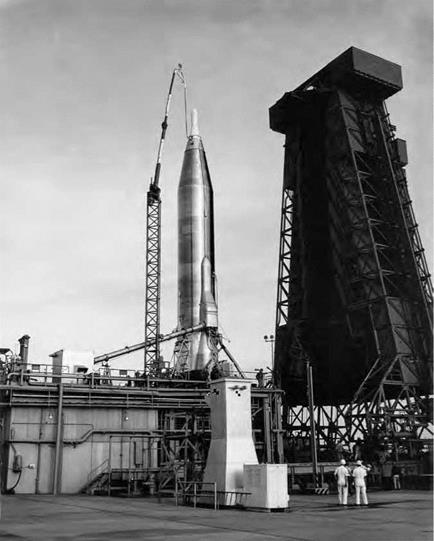Ablative and Radiative Structures
Atmosphere entry of satellites takes place above Mach 20, only slightly faster than the speed of reentry of an ICBM nose cone. The two phenomena nevertheless are quite different. A nose cone slams back at a sharp angle, decelerating rapidly and encountering heating that is brief but very severe. Entry of a satellite is far easier, taking place over a number of minutes.
To learn more about nose cone reentry, one begins by considering the shape of a nose cone. Such a vehicle initially has high kinetic energy because of its speed. Following entry, as it approaches the ground, its kinetic energy is very low. Where has it gone? It has turned into heat, which has been transferred both into the nose cone and into the air that has been disturbed by passage of the nose cone. It is obviously of interest to transfer as much heat as possible into the surrounding air. During reentry, the nose cone interacts with this air through its bow shock. For effective heat transfer into the air, the shock must be very strong. Hence the nose cone cannot be sharp like a church steeple, for that would substantially weaken the shock. Instead, it must be blunt, as H. Julian Allen of the National Advisory Committee for Aeronautics (NACA) first recognized in 1951.[1030]
Now that we have this basic shape, we can consider methods for cooling. At the outset of the Atlas ICBM program, in 1953, the simplest method of cooling was the heat sink, with a thick copper shield absorbing the heat of reentry. An alternative approach, the hot structure, called for an outer covering of heat-resistant shingles that were to radiate away the heat. A layer of insulation, inside the shingles, was to protect the primary structure. The shingles, in turn, overlapped and could expand freely.
A third approach, transpiration cooling, sought to take advantage of the light weight and high heat capacity of boiling water. The nose cone was to be filled with this liquid; strong g-forces during deceleration in the atmosphere were to press the water against the hot inner skin. The skin was to be porous, with internal steam pressure forcing the fluid
|
|
|
|
through the pores and into the boundary layer. Once injected, steam was to carry away heat. It would also thicken the boundary layer, reducing its temperature gradient and hence its rate of heat transfer. In effect, the nose cone was to stay cool by sweating.
Still, each of these approaches held difficulties. Transpiration cooling was poorly understood as a topic for design. The hot-structure concept raised questions of suitably refractory metals along with the prospect
of losing the entire nose cone if a shingle came off. Heat sinks appeared to promise high weight. But they seemed the most feasible way to proceed, and early Atlas designs specified use of a heat-sink nose cone.[1031]
Atlas was an Air Force program. A separate set of investigations was underway within the Army, which supported hot structures but raised problems with both heat sink and transpiration. This work anticipated the independent studies of General Electric’s George Sutton, with both efforts introducing an important new method of cooling: ablation. Ablation amounted to having a nose cone lose mass by flaking off when hot. Such a heat shield could absorb energy through latent heat, when melting or evaporating, and through sensible heat, with its temperature rise. In addition, an outward flow of ablating volatiles thickened the boundary layer, which diminished the heat flow. Ablation promised all the advantages of transpiration cooling, within a system that could be considerably lighter and yet more capable, and that used no fluid.[1032]
Though ablation proved to offer a key to nose cone reentry, experiments showed that little if any ablation was to be expected under the relatively mild conditions of satellite entry. But satellite entry involved high total heat input, while its prolonged duration imposed a new requirement for good materials properties as insulators. They also had to stay cool through radiation. It thus became possible to critique the usefulness of ICBM nose cone ablators for the new role of satellite entry.[1033]
Heat of ablation, in British thermal units (BTU) per pound, had been a standard figure of merit. Water, for instance, absorbs nearly 1,000 BTU/lb when it vaporizes as steam at 212 °F. But for satellite entry, with little energy being carried away by ablation, head of ablation could be irrelevant. Phenolic glass, a fine ICBM material with a measured heat of 9,600 BTU/lb, was unusable for a satellite because it had an unacceptably high thermal conductivity. This meant that the prolonged thermal soak of a satellite entry could have enough time to fry a spacecraft.
Teflon, by contrast, had a measured heat only one-third as large. It nevertheless made a superb candidate because of its excellent properties as an insulator.[1034]
Hence it became possible to treat the satellite problem as an extension of the ICBM problem. With appropriate caveats, the experience and research techniques of the ICBM program could carry over to this new realm. The Central Intelligence Agency was preparing to recover satellite spacecraft at the same time that the Air Force was preparing to fly full-size Atlas nose cones, with both being achieved in April 1959.
The Army flew a subscale nose cone to intermediate range in August 1958, which President Dwight Eisenhower displayed during a November news conference. The Air Force became the first to fly a nose cone to intercontinental range, in July 1958. Both flights carried a mouse, and both mice survived their reentry, but neither was recovered. Better success came the following April, when an Atlas launched the full – size RVX-l nose cone, and the Discoverer II reconnaissance spacecraft returned safely through the atmosphere—though it fell into Russian, not American, hands.[1035]











